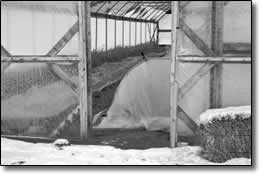
Wintergreens
by Chef Boy Ari

When thinking of fresh, local wintertime foods, something that doesn't usually come to mind is salad. Snow, yes. Cold, yes. Dark days, yes.Rock-hard, frozen ground, yes. All of these things are consistent with Northern winter, but inconsistent with fresh leafy greens.
This, however, is no longer quite the case. For the past few years, a young man known as the Greenoisseur has been developing ways to grow salad greens inside greenhouses within greenhouses. The Greennoisseur acknowledges getting most of his ideas from Maine farmer Elliot Coleman, whose book, Four Season Harvest, is a must-read for anyone interested in extending their growing season, anywhere in temperate climates.
General information like Coleman's must nonetheless be fine-tuned to suit the particular place where one is farming.Thus, the Greennoiseur and his associates have tested many designs and materials and have experimented with many different types of greens, determining which do the best in winter in our own local climate. One of the greens he has tried, mache, was recently discussed in The New Yorker in a very interesting article about a man named Todd Koons, who grew up to be a leading innovator in California's salad renaissance. The article covers everything from the history of salad in California to how, as a young lad, Koons went to work as a salad maker at the legendary Chez Panisse in Berkeley. Soon he was getting it on with his legendary boss, Alice Waters, nearly twice his age. This partnership changed the face of salad.
Nowadays, Koons' newest project/obsession is the salad green mache, long a staple in France. Not coincidentally, mache is also the newest hot item in Northern California's Salinas Valley salad scene. And the Salinas Valley is to salad what Nashville is for country music.
Koons' mache empire is in no immediate danger from the Greenoisseur, however - at least in winter - because he has determined that mache can't handle the cold. Nor can escarole, endive, frisee and most any kind of lettuce except romaine. But while mache may be too finicky for Northern winters, the Greennoisseur and his associate, Snip Dogg, have discovered that many greens actually yield a better product in winter than in summer. "To the trained salad eater," explained Snip Dogg, "the cold clearly takes a bitter edge off of the greens in the mustard family, like kale and arugula. Spinach tastes better too."
The Greennoisseur was shaking his head. "It's gotten to the point," he said, "where I can't even eat summer arugula anymore."
I learned all of this while standing in the fields of the Garden City Harvest community farm in Missoula's Rattlesnake Valley. The December sky was gray and blowing hard, and the fields were brown. In the middle of this cold and forlorn place, the Greenoisseur and Snip Dogg were sitting on upturned five gallon buckets. They held scissors with yellow rubber gloves, and they were snipping baby spinach, leaf by leaf. My hands were so cold I could barely hold my pen to the notebook, much less read my stiff scribbles. The boys of salad were cheerful.
"We're still harvesting spinach we planted in August," said Snip Dogg. "We weren't expecting the outdoor stuff to do this well. That's a nice bonus."
To help the spinach keep growing, they keep it covered with reme, a white fabric that insulates sensitive plants against the cold, but still lets in the light. Inside the greenhouses some of the beds are covered in reme as well. It's warm in there, especially in the inner greenhouses. Moisture beads on the inside of the plastic, and the plants are lush.
The Greennoisseur and Snip Dog operate a community salad service called Wintergreens. They harvest for 20 clients every week, each of whom receives over a half pound of salad mix. The clients pay between $100 to $150, based on a sliding scale, for 20 weeks' worth of salad, from October to March. If you go to the store in wintertime and look at the price for California salad, you will see that the Wintergreens clients are getting quite a deal.
Meanwhile, the boys of salad continue to experiment with new techniques, materials and plant varieties, and they continue to be surprised and inspired by what they learn.And they've got big plans for next year. They want to increase production, add clients (from their waiting list), try other veggies, and maybe even pick up some wintertime restaurant accounts.
Thus, what started as a school project has turned into a job. "I got sick of writing papers and turning them in," reflected the Greenoisseur, as he munched upon a leaf of spinach. "This is so much more real, so much more satisfying."
"And the chicks," reflected Snipp Dogg. "Chicks really dig salad. That's a nice bonus." ☯
|